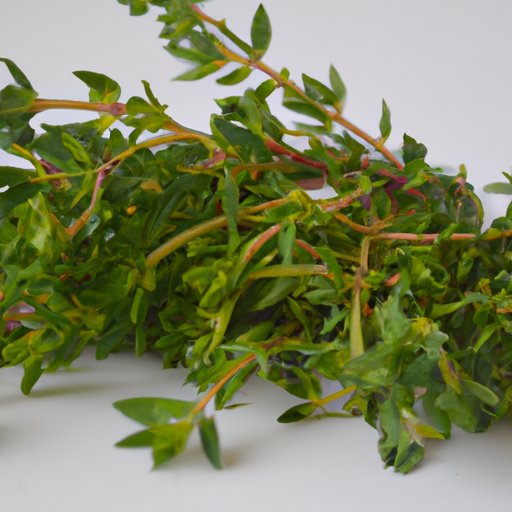Introduction
Thyme is an aromatic herb that has been used in cooking for centuries. Its subtle earthy flavor makes it a popular addition to many dishes, from soups to roasts. But what is thyme good for in cooking? In this comprehensive guide, we’ll explore the benefits of using thyme in cooking, how to incorporate it into your favorite recipes for healthier meals, and the best ways to use thyme in your cooking for maximum flavor.

Exploring the Benefits of Thyme in Cooking: A Comprehensive Guide
Thyme is a versatile herb with many nutritional benefits. It contains several vitamins and minerals, including vitamin A, vitamin C, iron, and calcium. Incorporating thyme into your diet can help boost the immune system, fight off infection, and reduce inflammation. It may also help improve digestion and reduce risk of certain chronic diseases.

How to Incorporate Thyme into Your Favorite Recipes for Healthier Meals
Adding thyme to recipes is easy and can enhance both the flavor and nutritional value of your meals. Here are some tips for incorporating thyme into your favorite dishes:
- Add fresh or dried thyme to soups, stews, sauces, and other slow-cooked dishes.
- Sprinkle thyme on top of roasted vegetables or potatoes.
- Toss thyme with olive oil and spread on breads before baking.
- Mix thyme with butter and herbs to make a compound butter for grilled meats or vegetables.
- Mix thyme with garlic, parsley, and lemon juice to make a marinade for fish or chicken.
The Best Ways to Use Thyme in Your Cooking for Maximum Flavor
There are several types of thyme to choose from, each with its own unique flavor and aroma. Here are some of the most common types of thyme and their uses:
- English thyme – This is the most commonly used type of thyme. It has a strong, pungent flavor and is great for soups, stews, and sauces.
- Lemon thyme – This type of thyme has a distinct citrus flavor. It pairs well with fish, poultry, and citrus fruits.
- French thyme – French thyme has a milder flavor than English thyme. It is often used in Mediterranean dishes such as ratatouille and bouillabaisse.
- Wild thyme – Wild thyme has a more intense flavor than other types of thyme. It is often used in Italian dishes such as pasta sauces.
When seasoning with thyme, it’s important to remember that the flavor will become more intense as the herb cooks. To get the most out of thyme, add it towards the end of the cooking process.

Easy Ways to Add More Thyme to Your Everyday Meals
Incorporating thyme into your everyday meals doesn’t have to be complicated. Here are some ideas for adding thyme to your meals:
- Add fresh or dried thyme to salad dressings.
- Sprinkle thyme on top of pizza or flatbreads before baking.
- Mix thyme with olive oil and brush onto grilled meats or vegetables.
- Toss thyme with cooked pasta or potatoes.
- Mix thyme with butter and herbs to make a compound butter for toast or biscuits.
A Guide to Understanding the Different Types of Thyme and Their Uses in Cooking
It’s important to understand the different types of thyme and their uses in cooking in order to get the most out of this flavorful herb. Here is a quick guide to understanding the different types of thyme:
- English thyme – The most commonly used type of thyme. Has a strong, pungent flavor and is great for soups, stews, and sauces.
- Lemon thyme – Has a distinct citrus flavor. Pairs well with fish, poultry, and citrus fruits.
- French thyme – Has a milder flavor than English thyme. Often used in Mediterranean dishes such as ratatouille and bouillabaisse.
- Wild thyme – Has a more intense flavor than other types of thyme. Often used in Italian dishes such as pasta sauces.
Different types of thyme work best with different types of dishes. For example, English thyme works well with hearty dishes like stews and soups, while lemon thyme pairs well with lighter dishes like fish and poultry. French thyme is great for Mediterranean dishes, and wild thyme is perfect for Italian dishes.
Conclusion
Thyme is an incredibly versatile herb that can add flavor and nutrition to your meals. Incorporating thyme into your diet can help boost the immune system, fight off infection, and reduce inflammation. Plus, it’s easy to add to almost any dish.


